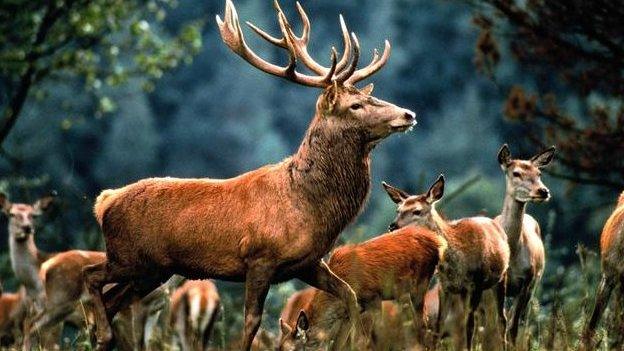Deer 'pose biggest threat' to Scotland's native woodlands
- Published

Estimates suggest there are more than 750,000 deer in Scotland
Deer represent the biggest threat to Scotland's native woodlands, according to an eight-year study by Forestry Commission scientists.
The publication of the Native Woodland Survey of Scotland has renewed debate over whether to cull deer.
Researchers said ancient woodland was being lost due to "excessive browsing and grazing", mainly by deer.
The findings of an inquiry into deer control by a Holyrood committee are due to be revealed later this week.
The report from Forestry Commission Scotland said 22.5% (311,153 ha) of Scotland's forests was native woodland. That equates to 4% of the land area of Scotland.
It said 42% of the country's native woodlands were in the Highlands.
In total, 46% of native woodland was said to be in a "satisfactory" condition for biodiversity. Researchers also found that over the past 40 years, a "significant" amount of ancient woodland in the uplands had been lost.
They identified deer as the most widespread threat to native woodland health and regeneration.
'Regulated approach'
Mike Daniels, head of land and science at the John Muir Trust, said: "This report confirms what most people who live in, work in or visit Scotland's countryside know - that overgrazing by excessive deer numbers is seriously damaging our native woodlands.
"We urgently need to move from a voluntary system of deer management to a sensible, regulated approach before we lose any more of our precious native woodland heritage."
Estimates suggest there are more than 750,000 deer in Scotland. The native red and roe deer are by far the most common but there are also smaller populations of Sika and fallow deer.
Claims from conservationists that the red deer population has trebled in the past 50 years are disputed by land managers, who argue the impact of Scotland's 6.6 million sheep should not be overlooked.
They say there are 2.5 million breeding ewes on the open deer range, mainly in the Highlands.
'Other factors'
Richard Cooke, chairman of the Association of Deer Management Groups and the Lowland Deer Network Scotland said: "This new piece of work, which we have not yet had time to study, will be extremely helpful in focusing deer management on areas where there are specific issues in relation to deer and native woodlands.
"We do believe, however, that there has been a significant turnaround in the last 30 years in the impacts of deer on native woodland and it is too easy to blame deer at every turn when other factors, for example grazing from other herbivores and now widespread tree disease, are also taking their toll."
The Scottish government said it was working to balance the needs of sporting estates, which rely on income from deer stalking, with the need to protect the environment.
Speaking at the launch of the Native Woodland Survey, the environment minister, Paul Wheelhouse told 大象传媒 Scotland: "We do very much value the rural jobs which are provided by sporting estates but we also have to manage the environment with great sensitivity.
"There's a number of different drivers for deer management and we need to take a more rounded view of what's required and make sure we get as much collaboration and voluntary action as possible."
- Published1 January 2013
- Published30 October 2012
- Published27 November 2012
- Published24 October 2012
- Published20 March 2012
- Published2 March 2012
- Published23 November 2011